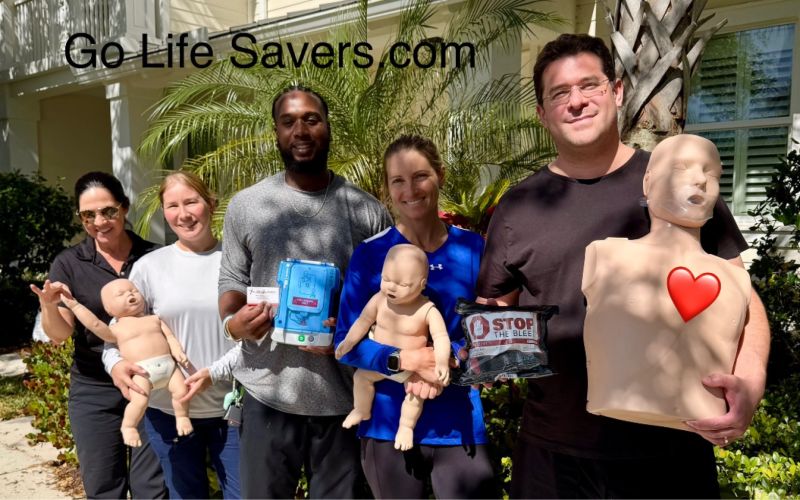Bystander CPR Learn CPR AED, First Aid, Stop The Bleed

Be equipped. Get empowered. Save a life.

Someone — maybe a friend or even a family member — has cardiac arrest right in front of you. Their heart has stopped beating. They need help. Would you know what to do?
A survey shows only 50% of Americans would perform lifesaving CPR. That’s because the other half don’t know what to do, fear legal ramifications, or hurting the victim, and think someone else will come to the rescue.
At Go life Savers, LLC, we get it. But the benefits of performing CPR far outweigh the risk and can double or triple the chance of survival. So don’t wait for someone else to step up. Learn CPR AED, First Aid and Stop The Bleed techniques. You might even save someone you love.
CPR – or Cardiopulmonary Resuscitation – is an emergency lifesaving procedure performed when the heart stops beating. Immediate CPR can double or triple chances of survival after cardiac arrest.
The American Heart Association invites you to share our vision: a world where no one dies from cardiac arrest. Every year, 350,000 people die from cardiac arrest in the United States. Big number. Bigger opportunity. With your help, we can bring that number down to zero.
Learn cardiopulmonary resuscitation (CPR), how to use an automated external defibrillator (AED), and apply basic first aid and Stop The Bleed techniques to double or triple chances of survival after cardiac arrest and other life threatening situations.
Why Is CPR Important?
Keeping the blood flow active – even partially – extends the opportunity for a successful resuscitation once trained medical staff arrive on site.
Chain of Survival
CPR is a critical step in the AHA’s Chain of Survival. The term Chain of Survival provides a useful metaphor for the elements of the ECC systems concept.
The 6 links in the adult out-of-hospital Chain of Survival are:
- Recognition of cardiac arrest and activation of the emergency response system (calling 9-1-1 in the US)
- Early CPR with an emphasis on chest compressions
- Rapid defibrillation
- Advanced resuscitation by Emergency Medical Services and other healthcare providers
- Post-cardiac arrest care
- Recovery (including additional treatment, observation, rehabilitation, and psychological support)
According to the American Heart Association, a strong Chain of Survival can improve chances of survival and recovery for victims of cardiac arrest.
Automated External Defibrillators (AED)CPR AED First Aid Stop The Bleed
AEDs can greatly increase a cardiac arrest victim’s chances of survival. To minimize the time to defibrillation for cardiac arrest victims, deployment of AEDs should not be limited to only trained people (although training is still recommended).
4 Million People Have Learned to Stop the Bleed
You can, too!
The American College of Surgeons Stop the Bleed program has prepared nearly 4 million people worldwide on how to stop bleeding in a severely injured person.
Contact: Go Life Savers, LLC at email: Mark@GoLifeSavers.com mobile/text: 901-409-3841. Serving Jupiter, West Palm Beach, Stuart, Port St. Lucie, and surrounding areas in the state of Florida and Ohio.
Mark L. Hughes, MBA, BSN, RN